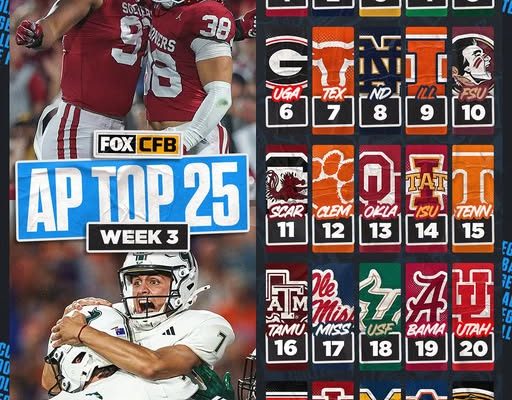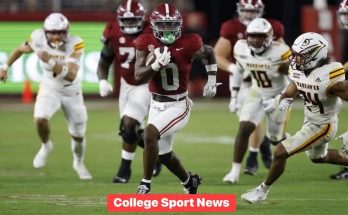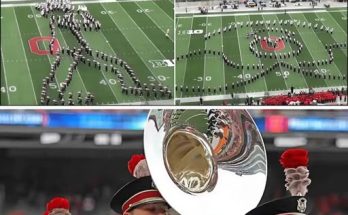The release of the Week 3 AP Top 25 has already sparked countless debates, conversations, and heated arguments across the college football landscape. Every Monday when the new poll comes out, fans race to social media, analysts flood sports networks with commentary, and players themselves take note of where their programs stand in the national conversation. Rankings are a central part of college football culture because they not only shape the perception of a team’s success but also play a major role in determining postseason opportunities, playoff chances, and national recognition. With the new Top 25 officially released, one of the biggest questions being asked right now is which team deserves to be ranked higher than where they currently sit. It is a question that is both simple and incredibly layered because the AP Poll is never just about wins and losses; it is about context, margin of victory, schedule strength, history, and even a dose of voter bias.
One of the first things to understand about the AP Poll is how voters arrive at these rankings. Each of the 63 panelists submits their personal Top 25, and points are assigned based on placement. The number one team on a ballot gets 25 points, number two gets 24 points, and so on down to number twenty-five which receives just one point. All those ballots are then aggregated, and the total points determine the official rankings. That means one voter might have a team much higher than the consensus, but unless enough panelists agree, that opinion does not carry as much weight. This is important because it reveals why some teams with similar records can be ranked in very different spots, and it also shows how early-season performances can disproportionately sway voters who are still searching for clarity about which teams are truly elite versus which ones are merely off to a hot start.
Through two weeks of play, the poll has already seen its fair share of movement. A handful of top ten teams have looked dominant and cemented themselves as clear playoff contenders, while others have stumbled early and seen their stock drop. But Week 3’s poll has placed even more emphasis on a few key debates. Should a one-loss team that lost to a top-ranked opponent be punished as harshly as a team that is undefeated but has faced weaker competition? Should preseason expectations still carry weight now that actual results are in? And which programs are benefiting from their brand recognition versus those who might be overlooked because of past failures? These questions make the AP Poll fascinating because they do not have straightforward answers, yet they drive the weekly narrative of college football.
Looking closely at the latest Top 25, there are several cases where the question “which team should be ranked higher?” feels particularly relevant. For example, a team like Texas is sitting high after a dominant showing in their opener, but some critics argue that their win should not carry as much weight until they prove consistency against elite competition. On the flip side, Ohio State, despite a convincing victory over a top program, has some questioning whether their offensive rhythm is sharp enough to justify their current standing. Then there are the surprise teams—programs that entered the season outside of the Top 25 or barely hanging around the edges but are now demanding attention after surprising starts. These are the teams that often cause the most controversy because they disrupt the expected order, and voters tend to be cautious before moving them too high too soon.
Take for instance a team like Florida State. They entered the season with high expectations, opened strong, and then delivered a statement win that pushed them firmly into the top half of the rankings. Yet some argue that based on the quality of their play, they should be even higher. They have shown balance on both sides of the ball, and their quarterback has been playing at a near-Heisman level. If voters are rewarding dominance and resume-building wins, Florida State’s case for climbing higher is compelling. But the AP Poll has a history of hesitancy when it comes to elevating programs that have recently experienced inconsistency. In that sense, FSU’s current spot might reflect more of a cautious “prove it” stance from voters rather than a true reflection of their performance so far.
Another example comes with Alabama, who suffered an early setback. The Crimson Tide are one of the most decorated programs in modern college football, but their Week 2 loss has sent shockwaves through the rankings. Some fans believe Alabama deserves to fall even further given the way they were outplayed, while others argue that punishing them too harshly ignores the reality that they lost to an elite opponent and still have one of the most talented rosters in the nation. The debate here reflects a broader philosophical divide in the way rankings are perceived. Should rankings represent what teams have done so far, or should they also account for what teams are expected to do moving forward? Alabama’s case is polarizing because it pits recent performance against historical credibility.
Meanwhile, teams like Notre Dame, Michigan, and Georgia are finding themselves in positions that are difficult to dispute. They have handled business early, shown glimpses of dominance, and retained the benefit of the doubt from voters who see them as playoff-caliber programs. Yet even within these cases, some critics wonder if their relatively soft early schedules should make them more vulnerable to sliding down the rankings until they prove themselves against tougher competition. For instance, if Georgia beats up on lower-level teams but struggles in conference play, will voters retroactively acknowledge that they may have been overrated early? These are the questions that only time can answer, but they add intrigue to the debate of which team is ranked too high or too low in Week 3.
Beyond the traditional powerhouses, the rise of programs like Utah, Oregon, and Penn State continues to add spice to the conversation. Each of these teams has shown flashes of being top ten worthy, but each also has moments that leave voters hesitant. Utah has looked gritty and resilient, especially on defense, but their offensive consistency remains in question. Oregon has explosive firepower but has not faced a defense that could test them at the highest level. Penn State looks balanced but has not yet been challenged by the type of opponent that reveals championship DNA. Should one of these teams be higher than they are currently ranked? Perhaps. But the AP Poll often waits for signature wins before giving full credit, and that might explain why they are positioned where they are.
The other side of the rankings is just as fascinating. Teams in the 20–25 range are often hanging on by a thread, and voters differ widely on which teams deserve those final spots. Programs like Kansas State, Ole Miss, and Tennessee find themselves battling not only opponents on the field but also the perception that they are second-tier within their own conferences. For these teams, every win matters a little more, and every loss is devastating. It is not uncommon for teams at the bottom of the poll to be ranked in one week and completely gone the next. In fact, many fans believe that certain teams outside the current Top 25—like an emerging Colorado or a gritty Washington State—deserve to be inside ahead of some of those ranked. These debates will only grow louder as conference play heats up and resume strength becomes more measurable.
When asking which team should be ranked higher, one cannot ignore the element of brand recognition in college football. Some programs, by virtue of their history and tradition, always seem to get the benefit of the doubt. Alabama, Ohio State, Michigan, Notre Dame, and USC are prime examples. On the flip side, teams like TCU or Baylor often have to fight for every inch of respect, even when their records and performances rival those of the blue bloods. This dynamic is part of what makes the AP Poll both captivating and frustrating. It is not just about what happens on the field; it is about perception, history, and narrative.
Ultimately, the Week 3 AP Top 25 has created another round of debates that will fuel fanbases until the next set of games kicks off. The truth is that no ranking system will ever please everyone. College football is a sport built on passion and loyalty, and fans will always feel their team deserves more respect than it gets. That is part of the magic. Whether it is Florida State being argued as top-five worthy, Alabama being questioned as overrated, or Utah and Oregon being seen as potential climbers, the AP Poll is doing what it is supposed to do: drive conversation, spark rivalries, and keep fans engaged.
As the season progresses, these rankings will change dramatically. Teams that are currently flying high may fall back down to earth, while underdogs lurking just outside the Top 25 could surge into the national spotlight with one or two big wins. For now, though, Week 3’s rankings serve as both a snapshot of where things stand and a reminder that college football is as unpredictable as it is passionate. The question of which team should be ranked higher will always have multiple answers, but the only way to truly settle those debates is on the field. And that is why Saturdays in the fall remain one of the most exciting spectacles in all of sports.



